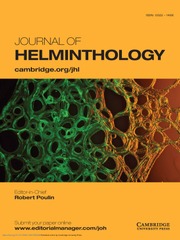Crossref Citations
This article has been cited by the following publications. This list is generated based on data provided by Crossref.
Archer, R.K.
and
Poynter, D.
1957.
Anaemia and eosinophilia associated with helminthiasis in young horses.
Journal of Comparative Pathology and Therapeutics,
Vol. 67,
Issue. ,
p.
196.
Thomas, R. J.
1959.
Field studies on the seasonal incidence of Nematodirus battus and N. filicollis in sheep.
Parasitology,
Vol. 49,
Issue. 3-4,
p.
387.
Field, A. C.
Brambell, M. R.
and
Campbell, J. Allan
1960.
Spring rise in faecal worm-egg counts of housed sheep, and its importance in nutritional experiments.
Parasitology,
Vol. 50,
Issue. 3-4,
p.
387.
Condy, J.B.
1961.
Seasonal Fluctuations in the Worm Egg Counts of Sheep in Southern Rhodesia.
British Veterinary Journal,
Vol. 117,
Issue. 4,
p.
152.
Spedding, C.R.W.
1962.
Modern Trends in Animal Health and Husbandry the Agricultural Ecology of Sheep Grazing.
British Veterinary Journal,
Vol. 118,
Issue. 11,
p.
461.
Michel, J. F.
1963.
The phenomena of host resistance and the course of infection of Ostertagia ostertagi in calves.
Parasitology,
Vol. 53,
Issue. 1-2,
p.
63.
Brunsdon, R.V.
1964.
The seasonal variations in the nematode egg counts of sheep: a comparison of the spring rise phenomenon in breeding and unmated ewes.
New Zealand Veterinary Journal,
Vol. 12,
Issue. 4,
p.
75.
Dunsmore, John D.
1965.
Ostertagiaspp. in Lambs and Pregnant Ewes.
Journal of Helminthology,
Vol. 39,
Issue. 2-3,
p.
159.
Tetley, J. H.
and
Langford, Barbara M.
1965.
A study of Nematode parasitism in hill-country breeding ewes.
New Zealand Journal of Agricultural Research,
Vol. 8,
Issue. 3,
p.
573.
Brunsdon, R.V.
1966.
Importance of the ewe as a source of trichostrongyle infection for lambs: Control of the spring-rise phenomenon by a single postlambing anthelmintic treatment.
New Zealand Veterinary Journal,
Vol. 14,
Issue. 8,
p.
118.
James, P. S.
and
Johnstone, I. L.
1967.
OVINE OSTERTAGIASIS.
Australian Veterinary Journal,
Vol. 43,
Issue. 9,
p.
379.
James, P. S.
and
Johnstone, I. L.
1967.
Studies with Ostertagia circumcincta in Sheep. I. The epidemiology of mature adults and arrested larvae.
Journal of Helminthology,
Vol. 41,
Issue. 2-3,
p.
137.
Brunsdon, R.V.
1967.
The spring-rise phenomenon: The relationship between the time of lambing and the commencement of the rise in faecal worm-egg counts.
New Zealand Veterinary Journal,
Vol. 15,
Issue. 3,
p.
35.
Procter, B.G.
and
Gibbs, H.C.
1968.
Spring rise phenomenon in ovine helminthiasis.
Experimental Parasitology,
Vol. 23,
Issue. 3,
p.
323.
Michel, J.F.
1969.
Advances in Parasitology Volume 7.
Vol. 7,
Issue. ,
p.
211.
Brunsdon, R.V.
1970.
The spring-rise phenomenon: Seasonal changes in the worm burdens of breeding ewes and in the availability of pasture infection.
New Zealand Veterinary Journal,
Vol. 18,
Issue. 4,
p.
47.
Brunsdon, R.V.
and
Vlassoff, A.
1971.
The post-parturient rise: A comparison of the pattern and relative generic composition of faecal strongyle egg counts in ewes and wethers.
New Zealand Veterinary Journal,
Vol. 19,
Issue. 3,
p.
32.
Brunsdon, R.V.
and
Vlassoff, A.
1971.
The post-parturient rise: A comparison of the pattern and relative generic composition of strongyle egg output from lactating and non-lactating ewes.
New Zealand Veterinary Journal,
Vol. 19,
Issue. 1-2,
p.
19.
Brunsdon, R.V.
1971.
The post-parturient rise in the faecal nematode egg count of ewes: Some host-parasite relationships.
New Zealand Veterinary Journal,
Vol. 19,
Issue. 5,
p.
100.
Gibson, T.E.
and
Everett, G.
1972.
The Acquisition of Trichostrongylid Infection by Grazing Lambs.
Research in Veterinary Science,
Vol. 13,
Issue. 3,
p.
268.


